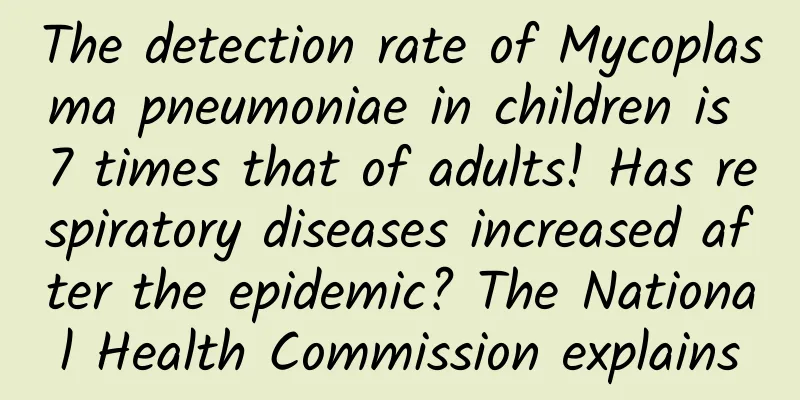The detection rate of Mycoplasma pneumoniae in children is 7 times that of adults! Has respiratory diseases increased after the epidemic? The National Health Commission explains

|
On November 13, at a press conference of the National Health Commission, Mi Feng, spokesperson of the National Health Commission, said that as various places gradually enter winter, respiratory diseases have entered the peak season, and multiple respiratory diseases are intertwined and superimposed. We must insist on the prevention and treatment of multiple diseases, pay close attention to the prevalence of Mycoplasma pneumoniae, new coronavirus infection, influenza, dengue fever, norovirus infection, etc., strengthen monitoring and early warning, and grasp changes in the intensity of virus activity, virus mutations, etc. Mi Feng said that it is necessary to strengthen infectious disease monitoring and health management in key areas and key places such as rural areas, schools, and nursing homes, do a good job in follow-up of key groups such as elderly patients with underlying diseases and children, and optimize vaccination services; it is necessary to coordinate medical resources, optimize diagnosis and treatment processes, strengthen outpatient, pediatric, respiratory and other departments, and do a good job in various medical treatments; it is necessary to continue to advocate a civilized, healthy, green and environmentally friendly lifestyle, and maintain good personal hygiene habits. The detection rate of Mycoplasma pneumoniae in children 7 times that of an adult Tong Zhaohui, director of the Beijing Institute of Respiratory Diseases, said that Mycoplasma pneumoniae is one of the common respiratory pathogens. According to China's 2016 Guidelines for Community-Acquired Pneumonia in China and relevant data monitoring, Mycoplasma pneumoniae is one of the important causes of community-acquired pneumonia in China. It is highly prevalent in autumn and winter every year, and children and adolescents are susceptible. Mycoplasma pneumoniae is mainly transmitted through respiratory droplets. Therefore, without protection, concentrated outbreaks can occur in densely populated places such as kindergartens and schools. It is also common for family members to be infected with Mycoplasma pneumoniae. The recent Mycoplasma pneumoniae nucleic acid test detection rate of the Beijing Institute of Respiratory Diseases is 5.59% for adults and 40.34% for children; the influenza antigen positive detection rate is 29.67% for adults and 4.94% for children. Parents give it to their children on their own Azithromycin and other drugs are not advisable Recently, some parents of children with the disease have followed online advice and given their children azithromycin and other drugs on their own. Wang Quan, chief physician at Beijing Children's Hospital, said that it is not advisable for parents to give their children azithromycin and other drugs on their own. It is currently the peak season for children's respiratory diseases. Although Mycoplasma pneumoniae infection accounts for a large proportion, overall, viruses are still the most common pathogens of children's respiratory infections. Common viruses include adenovirus, rhinovirus, influenza virus, parainfluenza virus, human metapneumovirus, etc. Azithromycin is ineffective and unreasonable for viral infections. In addition, children are young and their organ functions are not fully developed. Drug abuse may cause adverse reactions in children. Azithromycin is a prescription drug and belongs to the macrolide class of antibacterial drugs. It is the first choice for Mycoplasma pneumoniae infection and should be used in accordance with the guidance of a physician or pharmacist , including appropriate dosage, appropriate course of treatment, and correct route of administration. Parents should be reminded that children are not smaller versions of adults, and medication cannot be used arbitrarily. Attention should be paid to its safety and effectiveness. How to use medication for treatment after the etiology is confirmed? Recently, many people on the Internet have said that their entire family has been infected with Mycoplasma pneumonia. Some people also believe that many adults are actually infected with the new coronavirus. Tong Zhaohui, director of the Beijing Institute of Respiratory Diseases, said that Mycoplasma pneumoniae is one of the common pathogens of respiratory infections. According to the 2016 edition of the "Guidelines for the Diagnosis and Treatment of Community-Acquired Pneumonia in Adults in China" and related monitoring data, Mycoplasma pneumoniae is one of the important pathogens of community-acquired pneumonia in my country. It is highly prevalent in autumn every year, and children and adolescents are susceptible. Mycoplasma pneumoniae is mainly transmitted through respiratory droplets. Therefore, in the absence of protection, it will cause concentrated outbreaks in densely populated places such as kindergartens and schools. It is also common for family members to be infected with Mycoplasma pneumoniae. Acute respiratory tract infection is a common respiratory disease. The symptoms caused by Mycoplasma pneumoniae, new coronavirus, influenza virus, etc. are similar, which can be clarified by antigen and nucleic acid detection methods. It is recommended that everyone use medication after confirming the etiology, rather than relying on guesswork and taking medication indiscriminately. Mycoplasma pneumonia in children Do we all need lung lavage? Wang Quan, chief physician at Beijing Children's Hospital, said that bronchoalveolar lavage through fiberoptic bronchoscope is a very important treatment for severe mycoplasma pneumonia in clinical practice. However, it is not recommended for mild mycoplasma pneumonia. In clinical work, when the doctor suspects that a child has developed plastic bronchitis or mucus plug obstruction, resulting in atelectasis, etc. after being infected with Mycoplasma pneumoniae, the child needs to be given lung lavage treatment as soon as possible, which is helpful in reducing complications and sequelae. A small number of children may need multiple lung lavage treatments during the entire hospitalization or in the later stages. Are there more respiratory infectious diseases after the epidemic? Many people feel that after the COVID-19 pandemic, there seem to be more respiratory infectious diseases around them, such as influenza A, mycoplasma pneumonia, mononucleosis, etc. How should we view this issue? Tong Zhaohui, director of the Beijing Institute of Respiratory Diseases, responded that winter is the peak season for respiratory infections every year. Common mycoplasma pneumoniae, respiratory viruses, and especially influenza viruses are more active than in summer or spring, leading to a significant increase in the number of infected people. The characteristics of these diseases are the same as in previous years, and the prognosis is good, so there is no need to worry. China's National Influenza Center monitors influenza activity in real time. Current monitoring data shows that China has entered the influenza season this year. Currently, influenza A is the main prevalence, and there is also influenza B. Mononucleosis is also a common disease in children and adolescents. It is mainly caused by Epstein-Barr virus or cytomegalovirus. The disease is self-limiting and the incidence rate has not increased compared with previous years. During the COVID-19 pandemic, due to the strict respiratory prevention and control measures adopted by everyone, the incidence of acute respiratory diseases including mycoplasma and influenza has indeed decreased. With the normalization of prevention and control, it is normal for these diseases to return to the pre-epidemic incidence level this year, so everyone feels that respiratory diseases have increased this year. In the past three years, the global monitoring of mycoplasma infection rates has been at a low level. Combined with the fact that Mycoplasma pneumonia itself has its own epidemic pattern, there is a periodic epidemic every 3-7 years. Therefore, mycoplasma pneumonia in children is on the rise this year, and everyone should pay attention. Personal protection is the key to prevention. Recent COVID-19 epidemic in my country The overall trend is fluctuating downward Wang Dayan, director of the National Influenza Center, Institute of Viral Diseases, Chinese Center for Disease Control and Prevention, said that the overall epidemic situation of novel coronavirus infection in my country has shown a fluctuating downward trend recently. Since late August this year, the number of reported novel coronavirus infection cases nationwide has declined for 10 consecutive weeks, and the positive rate of novel coronavirus nucleic acid testing in outpatient sentinel hospitals across the country has also shown a continuous downward trend. Global and domestic monitoring data show that the new coronavirus variants currently prevalent in the world and my country all belong to the Omicron variant. The sequencing results of the viruses sampled in the latest week show that they are all sub-branches of XBB, and no variants with significant changes in biological characteristics have been found. The country is still conducting systematic multi-channel monitoring of the new coronavirus, and the data is regularly published on the website of the China Center for Disease Control and Prevention. In daily life How to prevent respiratory diseases scientifically? Wang Dayan, director of the National Influenza Center of the Institute of Viral Diseases of the Chinese Center for Disease Control and Prevention, said that winter and spring are the peak seasons for respiratory infectious diseases such as influenza. The most effective and economical way to prevent infectious diseases is to get vaccinated. Flu vaccination can effectively reduce the risk of infection, disease and severe illness. In addition, the public can reduce the risk of infection and transmission by mastering the basic knowledge of common respiratory infectious diseases and taking scientific prevention methods in daily life. First, a healthy lifestyle is an important guarantee for enhancing physical fitness and improving physical resistance. In daily life, we should maintain adequate sleep, adequate nutrition, and appropriate physical exercise. Second, developing good personal hygiene habits can reduce the risk of infection. For example, when coughing or sneezing, cover your mouth and nose with a tissue, towel or elbow; pay attention to hand hygiene, wash your hands frequently, especially after coughing or sneezing; try to avoid touching your eyes, nose or mouth. Third, pay attention to keeping the home and workplace environment clean. Open windows regularly for ventilation indoors. In winter, the outdoor temperature is low, and you should also pay attention to keeping warm during ventilation. If there is a patient with respiratory tract infection in the family, wear a mask when taking care of the patient. Fourth, high-risk groups such as the elderly, children, and patients with underlying diseases should try to avoid crowded public places, especially closed places with poor air circulation, to reduce the chance of contact with sick people. When going to closed and crowded places or taking public transportation, it is recommended to wear a mask and pay attention to changing it in time. Finally, it should be reminded that once respiratory infection symptoms such as fever and cough occur, the patient should rest at home to avoid transmitting the pathogen to other people . If the symptoms are severe, you should take personal protection measures, go to the hospital as soon as possible, and get effective treatment in time. Source: Beijing Evening News WeChat Official Account |
<<: 【Health Lecture】Five prescriptions for cardiac rehabilitation --- exercise prescription
>>: Popular knowledge about mycoplasma pneumonia in children
Recommend
Why is my period dark red?
During the menstrual period, women will pay speci...
What should I do if my menstrual flow is heavy after miscarriage?
Many women will experience heavier menstrual flow...
How does a man feel after giving birth?
Women will experience vaginal relaxation to a cer...
How do girls train their arm muscles?
In addition to male friends who like muscular bod...
Why do I keep farting during late pregnancy?
When the expectant mother's pregnancy reaches...
Why do pregnant women often hold their breath?
Pregnant women often feel short of breath, which ...
What causes swollen and painful nipples?
Breasts are important organs for women and have t...
Treatment of endometrial thickening 14mm
The uterus is an important reproductive organ for...
What are the reactions of the first month of pregnancy?
Getting married and having children are major eve...
What are the dangers of pelvic cysts?
The female pelvic cavity is an important area of ...
Will uterine fibroids still grow after menopause?
Uterine fibroids are mobile benign tumors that oc...
A woman dreams of her teeth being loose but not falling out
Normally, toothache does not seem to be a serious...
Chinese medicine for female urinary tract infection
Our body needs a lot of water every day to mainta...
Is it still necessary to have a uterine curettage for a spontaneous abortion?
Spontaneous miscarriage can also cause great harm...
What causes abdominal pain and lower back pain after abortion?
There are only two ways of abortion nowadays, nam...

![[Medical Q&A] What is quietly affecting the intake of vitamin B?](/upload/images/67f105fada8cd.webp)







